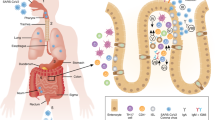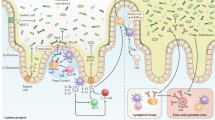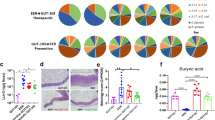Abstract
An interaction between infection and IBD was identified soon after Crohn's disease and ulcerative colitis were first described. Since then it has become apparent that infectious agents are involved with both the etiopathogenesis and clinical course of IBD on several levels. Whilst our understanding of this interplay is incomplete, it is clear that infections can initiate both the onset and relapse of IBD. Furthermore, the disease process itself predisposes patients to certain infections, and many drugs used to treat IBD also increase the risk of infectious complications. Attempts to establish the relative infectious risks associated with the drugs used to treat IBD remain in an early stage; but it seems that the greatest risks relate to the combined use of immunomodulating agents rather than to individual drugs. The risk of infections in patients with IBD might also be exacerbated by underuse of, and perhaps substandard response to, vaccinations. It is axiomatic that physicians treating patients with IBD must be aware of these infectious risks and of strategies to minimize them. Meanwhile, intriguing advances in the use of parasitic agents as a treatment for ulcerative colitis and Crohn's disease have introduced a new angle to the interplay between infections and IBD.
Key Points
-
Infection can initiate the onset of IBD, but it is unlikely that IBD is caused by a single pathogenic agent
-
Relapse of IBD is also associated with intercurrent infection, which should be looked for in all patients presenting with active IBD: treatment of infections might avoid inappropriate or unnecessary use of steroids, immunomodulators or biologics
-
IBD can predispose to infectious complications, either directly as part of the disease process (e.g. abscess formation in Crohn's disease) or indirectly (e.g. by causing malnutrition)
-
Many drugs used to treat IBD predispose patients to infection: it remains unclear which individual drugs carry the highest risk, but the use of these drugs in combination clearly increases the risk of infection
-
The use of screening tests and, where appropriate, prophylactic therapy or vaccination decreases the risk of therapy-associated infections
-
Nonpathogenic parasites represent a new and apparently safe form of therapy for IBD
This is a preview of subscription content, access via your institution
Access options
Subscribe to this journal
Receive 12 print issues and online access
$209.00 per year
only $17.42 per issue
Buy this article
- Purchase on Springer Link
- Instant access to full article PDF
Prices may be subject to local taxes which are calculated during checkout
Similar content being viewed by others
References
Ohkusa T, Nomura T, Sato N (2004) The role of bacterial infection in the pathogenesis of inflammatory bowel disease. Intern Med 43: 534–539
Shanahan F, O'Mahony J (2005) The mycobacteria story in Crohn's disease. Am J Gastroenterol 100: 1537–1538
Gibson PR (1997) Ulcerative colitis: an epithelial disease. Baillieres Clin Gastroenterol 11: 17–33
Ryan P et al. (2004) Bacterial DNA within granulomas of patients with Crohn's disease—detection by laser capture microdissection and PCR. Am J Gastroenterol 99: 1539–1543
Ryan P et al. (2002) PCR detection of Mycobacterium paratuberculosis in Crohn's disease granulomas isolated by laser capture microdissection. Gut 51: 665–670
Nuding S et al. (2007) Reduced mucosal antimicrobial activity in Crohn's disease of the colon. Gut 56: 1240–1247
Hugot JP et al. (2001) Association of NOD2 leucine-rich repeat variants with susceptibility to Crohn's disease. Nature 411: 599–603
Marks DJ et al. (2006) Defective acute inflammation in Crohn's disease: a clinical investigation. Lancet 367: 668–678
Vignal C et al. (2007) How NOD2 mutations predispose to Crohn's disease. Microbes Infect 9: 658–663
Peyrin-Biroulet L and Chamaillard M (2007) NOD2 and defensins: translating innate to adaptive immunity in Crohn's disease. J Endotoxin Res 13: 135–139
Powell SJ and Wilmot AJ (1966) Ulcerative post-dysenteric colitis. Gut 7: 438–443
Garcia Rodriguez LA et al. (2006) Acute gastroenteritis is followed by an increased risk of inflammatory bowel disease. Gastroenterology 130: 1588–1594
Schumacher G et al. (1993) A prospective study of first attacks of inflammatory bowel disease and non-relapsing colitis. Microbiologic findings. Scand J Gastroenterol 28: 1077–1085
Mylonaki M et al. (2004) Enteric infection in relapse of inflammatory bowel disease: importance of microbiological examination of stool. Eur J Gastroenterol Hepatol 16: 775–778
Issa M et al. (2007) Impact of Clostridium difficile on inflammatory bowel disease. Clin Gastroenterol Hepatol 5: 345–351
Rodemann JF et al. (2007) Incidence of Clostridium difficile infection in inflammatory bowel disease. Clin Gastroenterol Hepatol 5: 339–344
Abbas MA et al. (2000) Colonic perforation in unsuspected amebic colitis. Dig Dis Sci 45: 1836–1841
Bertalot G et al. (2001) Evidence of Epstein-Barr virus infection in ulcerative colitis. Dig Liver Dis 33: 551–558
Hommes DW et al. (2004) The pathogenicity of cytomegalovirus in inflammatory bowel disease: a systematic review and evidence-based recommendations for future research. Inflamm Bowel Dis 10: 245–250
Kandiel A and Lashner B (2006) Cytomegalovirus colitis complicating inflammatory bowel disease. Am J Gastroenterol 101: 2827–2865
Hommes DW (2006) CMV co-infection—does it matter? In Clinical Dilemmas in Inflammatory Bowel Disease, 159–163 (Eds Irving PM. et al.) Oxford, UK: Blackwell
Criscuoli V et al. (2004) Severe acute colitis associated with CMV: a prevalence study. Dig Liver Dis 36: 818–820
Papadakis KA et al. (2001) Outcome of cytomegalovirus infections in patients with inflammatory bowel disease. Am J Gastroenterol 96: 2137–2142
Matsuoka K et al. (2007) Cytomegalovirus is frequently reactivated and disappears without antiviral agents in ulcerative colitis patients. Am J Gastroenterol 102: 331–337
Samuel S and Mahida YR (2006) Intestinal infections: mimics and precipitants of relapse. In Clinical Dilemmas in Inflammatory Bowel Disease, 217–221 (Eds Irving P. et al.) Oxford: Blackwell
Winther KV et al. (2003) Survival and cause-specific mortality in ulcerative colitis: follow-up of a population-based cohort in Copenhagen County. Gastroenterology 125: 1576–1582
Jess T et al. (2002) Mortality and causes of death in Crohn's disease: follow-up of a population-based cohort in Copenhagen County, Denmark. Gastroenterology 122: 1808–1814
Ben Ami H et al. (2002) Diagnosis and treatment of urinary tract complications in Crohn's disease: an experience over 15 years. Can J Gastroenterol 16: 225–229
Pirlich M et al. (2003) Prevalence of malnutrition in hospitalized medical patients: impact of underlying disease. Dig Dis 21: 245–251
O'Sullivan M and O'Morain C (2006) Nutrition in inflammatory bowel disease. Best Pract Res Clin Gastroenterol 20: 561–573
Scrimshaw NS (2003) Historical concepts of interactions, synergism and antagonism between nutrition and infection. J Nutr 133: 316S–321S
Camus P and Colby TV (2000) The lung in inflammatory bowel disease. Eur Respir J 15: 5–10
Gelzayd EA et al. (1968) Nephrolithiasis in inflammatory bowel disease. Am J Dig Dis 13: 1027–1034
Fausa O et al. (1991) Relationship of inflammatory bowel disease and primary sclerosing cholangitis. Semin Liver Dis 11: 31–39
Melmed GY et al. (2006) Patients with inflammatory bowel disease are at risk for vaccine-preventable illnesses. Am J Gastroenterol 101: 1834–1840
Sands BE et al. (2004) Guidelines for immunizations in patients with inflammatory bowel disease. Inflamm Bowel Dis 10: 677–692
Sanchez-Fructuoso AI et al. (2000) Influenza virus immunization effectivity in kidney transplant patients subjected to two different triple-drug therapy immunosuppression protocols: mycophenolate versus azathioprine. Transplantation 69: 436–439
Dotan I et al. (2007) Azathioprine (AZA)/6-mercaptopurine (6MP) therapy has no significant effect on cellular or humoral immune responses in patients with inflammatory bowel disease. Gastroenterology 4 (Suppl 2): A51
Lichtenstein GR et al. (2006) Serious infections and mortality in association with therapies for Crohn's disease: TREAT registry. Clin Gastroenterol Hepatol 4: 621–630
Stuck AE et al. (1989) Risk of infectious complications in patients taking glucocorticosteroids. Rev Infect Dis 11: 954–963
Connell WR et al. (1993) Bone marrow toxicity caused by azathioprine in inflammatory bowel disease: 27 years of experience. Gut 34: 1081–1085
Lamers CB et al. (1999) Azathioprine: an update on clinical efficacy and safety in inflammatory bowel disease. Scand J Gastroenterol Suppl 230: 111–115
Present DH et al. (1989) 6-Mercaptopurine in the management of inflammatory bowel disease: short- and long-term toxicity. Ann Intern Med 111: 641–649
Bernatsky S et al. (2007) Anti-rheumatic drug use and risk of serious infections in rheumatoid arthritis. Rheumatology (Oxford) 46: 1157–1160
Toruner M et al. (2006) Risk factors for opportunistic infections in inflammatory bowel diseases: a case-control study. Gastroenterology 130 (Suppl 2): 96
2007 Periodic Safety Update Report (PSUR): Infliximab. April
Wallis R.S et al. (2004) Granulomatous infectious diseases associated with tumor necrosis factor antagonists. Clin Infect Dis 38: 1261–1265
Irving PM et al. (2007) Review article: appropriate use of corticosteroids in Crohn's disease. Aliment Pharmacol Ther 26: 313–329
Carmona L et al. (2005) Effectiveness of recommendations to prevent reactivation of latent tuberculosis infection in patients treated with tumor necrosis factor antagonists. Arthritis Rheum 52: 1766–1772
Hernandez-Cruz B et al. (1999) Tuberculosis prophylaxis in patients with steroid treatment and systemic rheumatic diseases. A case-control study. Clin Exp Rheumatol 17: 81–87
Winthrop KL (2006) Risk and prevention of tuberculosis and other serious opportunistic infections associated with the inhibition of tumor necrosis factor. Nat Clin Pract Rheumatol 2: 602–610
Slifman NR et al. (2003) Listeria monocytogenes infection as a complication of treatment with tumor necrosis factor alpha-neutralizing agents. Arthritis Rheum 48: 319–324
Nathan DM et al. (2006) Hepatitis B and C virus infections and anti-tumor necrosis factor-alpha therapy: guidelines for clinical approach. J Gastroenterol Hepatol 21: 1366–1371
Arts J et al. (2004) Long-term outcome of treatment with intravenous cyclosporin in patients with severe ulcerative colitis. Inflamm Bowel Dis 10: 73–78
Farthing MJG (2003) Infectious colitis. In Inflammatory Bowel Disease: From Bench to Bedside, 845–861 (Eds Targan S. et al.) New York: Springer
Malchow H et al. (1984) European Cooperative Crohn's Disease Study (ECCDS): results of drug treatment. Gastroenterology 86: 249–266
Sands BE et al. (2004) Infliximab maintenance therapy for fistulizing Crohn's disease. N Engl J Med 350: 876–885
Mayberry J and Mann R (1989) Inflammatory bowel disease in rural sub-Saharan Africa: rarity of diagnosis in patients attending mission hospitals. Digestion 44: 172–176
Gent AE et al. (1994) Inflammatory bowel disease and domestic hygiene in infancy. Lancet 343: 766–767
Summers RW et al. (2003) Trichuris suis seems to be safe and possibly effective in the treatment of inflammatory bowel disease. Am J Gastroenterol 98: 2034–2041
Summers RW et al. (2005) Trichuris suis therapy for active ulcerative colitis: a randomized controlled trial. Gastroenterology 128: 825–832
Summers RW et al. (2005) Trichuris suis therapy in Crohn's disease. Gut 54: 87–90
Croese J et al. (2006) A proof of concept study establishing Necator americanus in Crohn's patients and reservoir donors. Gut 55: 136–137
Shin JL et al. (2004) Does whipworm increase the pathogenicity of Campylobacter jejuni? A clinical correlate of an experimental observation. Can J Gastroenterol 18: 175–177
Kradin RL et al. (2006) Iatrogenic Trichuris suis infection in a patient with Crohn disease. Arch Pathol Lab Med 130: 718–720
Summers RW et al. (2006) Therapeutic colonization with Trichuris suis. Arch Pathol Lab Med 130: 1753–1754
Sartor RB (2005) Probiotic therapy of intestinal inflammation and infections. Curr Opin Gastroenterol 21: 44–50
Ewaschuk JB and Dieleman LA (2006) Probiotics and prebiotics in chronic inflammatory bowel diseases. World J Gastroenterol 12: 5941–5950
Bongartz T et al. (2006) Anti-TNF antibody therapy in rheumatoid arthritis and the risk of serious infections and malignancies: systematic review and meta-analysis of rare harmful effects in randomized controlled trials. JAMA 295: 2275–2285
Colombel JF et al. (2004) The safety profile of infliximab in patients with Crohn's disease: the Mayo clinic experience in 500 patients. Gastroenterology 126: 19–31
Esteve M et al. (2004) Chronic hepatitis B reactivation following infliximab therapy in Crohn's disease patients: need for primary prophylaxis. Gut 53: 1363–1365
Ghosh S et al. (2003) Natalizumab for active Crohn's disease. N Engl J Med 348: 24–32
Van Assche G et al. (2005) Progressive multifocal leukoencephalopathy after natalizumab therapy for Crohn's disease. N Engl J Med 353: 362–368
Author information
Authors and Affiliations
Corresponding author
Ethics declarations
Competing interests
Peter R Gibson is a Consultant for Abbott Australasia, Centocor, Falk Pharma, Ferring Pharmaceuticals, Pharmatel Fresenius Kabi, Orphan Australia, Nycomed and Schering Plough. He is a Speaker for Ferring Pharmaceuticals and Pharmatel Fresenius Kabi, and has received grant/research support Ferring Pharmaceuticals, Pharmatel Fresenius Kabi and Nycomed. Peter M Irving declared no competing interests.
Rights and permissions
About this article
Cite this article
Irving, P., Gibson, P. Infections and IBD. Nat Rev Gastroenterol Hepatol 5, 18–27 (2008). https://doi.org/10.1038/ncpgasthep1004
Received:
Accepted:
Issue Date:
DOI: https://doi.org/10.1038/ncpgasthep1004
This article is cited by
-
Pancreatic Disorders in Patients with Inflammatory Bowel Disease
Digestive Diseases and Sciences (2022)
-
A comprehensive review of vaccination in patients with inflammatory bowel diseases: An Indian perspective
Indian Journal of Gastroenterology (2020)
-
Patients’ perceptions on the impact of coffee consumption in inflammatory bowel disease: friend or foe? – a patient survey
Nutrition Journal (2015)
-
Reisediarrhö
Der Gastroenterologe (2014)
-
VEGF-A isoform modulation in an preclinical TNBS model of ulcerative colitis: protective effects of a VEGF164b therapy
Journal of Translational Medicine (2013)



